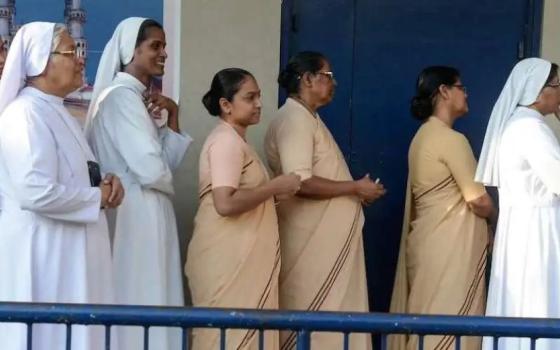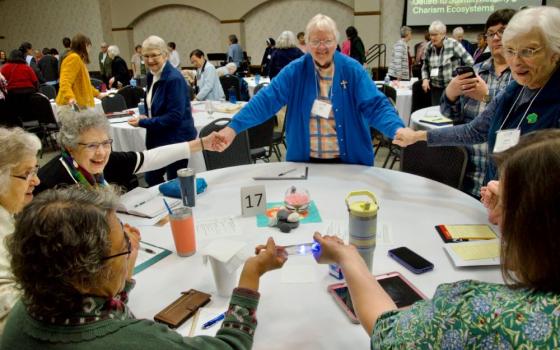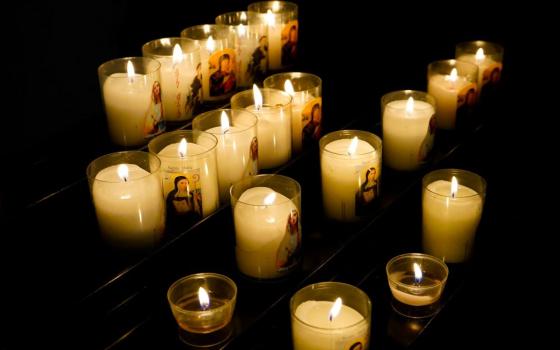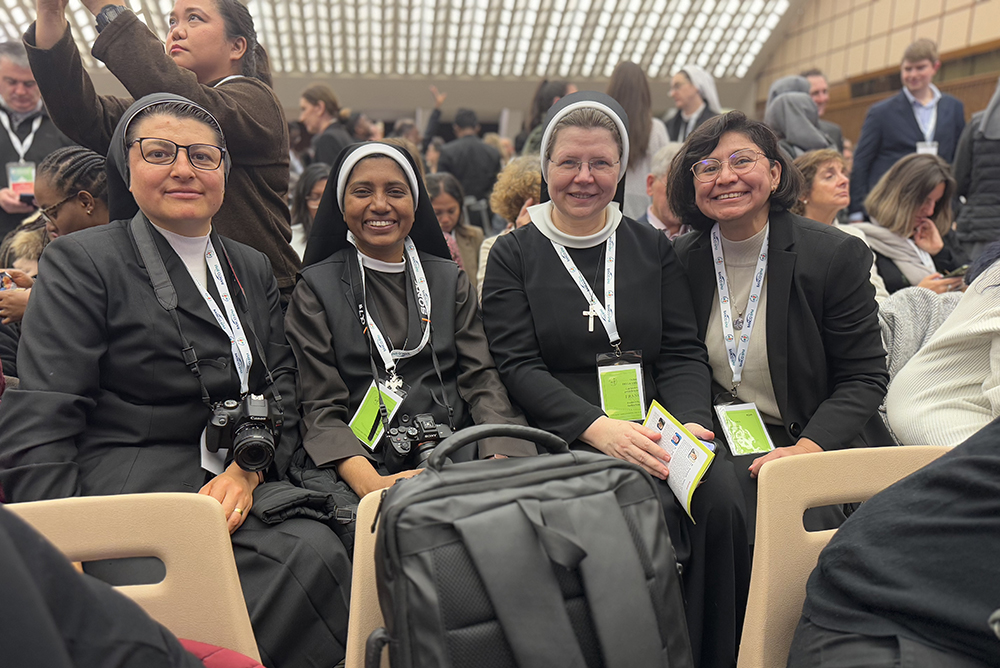
Srs. Rocio Garcia of the Daughters of Mary Immaculate of Guadalupe (Father Plancarte) Mexico, Lismy Parayil of the Congregation of Mother of Carmel of India, Karolina Luczak of the Sisters of the Holy Nazareth from Poland, and Helga Leija of the Benedictine Sisters of Mount St. Scholastica in Atchison, Kansas, in the United States wait for the pope's private audience at the Paul VI Audience Hall Jan. 25, 2025. (Helga Leija)
On Aug. 9, 2024, I received an email from the Dicastery of Communication inviting me to attend the Global Jubilee Conference with Religious Sisters in Rome, Italy. At first, I thought it might be a scam. But when I saw the email ended in .va, my heart swelled with excitement.
The Global Jubilee Conference was organized as a side event of the Jubilee of the World of Communications, which took place in Rome Jan. 24-26. Sisters from all corners of the world — Europe, Africa, the Americas, Oceania, and Asia — came together with communication professionals to reflect on the pope's 2025 Jubilee theme, "Pilgrims of Hope." The event provided the opportunity to share experiences and discuss important topics affecting the world of communications today.
The organization of the event was magnificent. I stayed just steps away from St. Peter's Basilica at a hostel owned by the Sisters of Maria Bambina, overlooking St. Peter's Square. It was the perfect location: everything was within walking distance, and I often found myself pausing to take in the beauty around me.
Advertisement
Behind the scenes of Vatican Media
For years, I had dreamed of seeing St. Peter's Basilica and the Sistine Chapel, and they did not disappoint. Their beauty is breathtaking! But if I'm being honest, my absolute favorite visit was to Vatican Media. As a translator, having a behind-the-scenes look at how the Vatican communicates with the world was a once-in-a-lifetime experience. Vatican Media, managed by the Dicastery of Communications, oversees several branches: Vatican News (the primary news platform); L'Osservatore Romano (the Vatican's daily newspaper); Vatican Radio, Vatican Television Center and Vatican Publishing House.
Touring the Vatican Media offices, I was struck by the dedication to accurate communication. Vatican Media publishes in 53 languages, and I was amazed to see the rows of offices where translators work to bring the Vatican's messages to the world. For me, this was like visiting Disneyland — only with a lot more dictionaries.
A window into history via Vatican Radio
Another powerful moment was the visit to Vatican Radio Museum where we learned how the Vatican has adapted to new technologies, from print media to digital platforms. Vatican Radio was founded in 1931 by Guglielmo Marconi at the request of Pope Pius XI. The museum displays historic broadcasting equipment, original recordings of significant speeches (including those of various popes), and demonstrations of technological advancements.
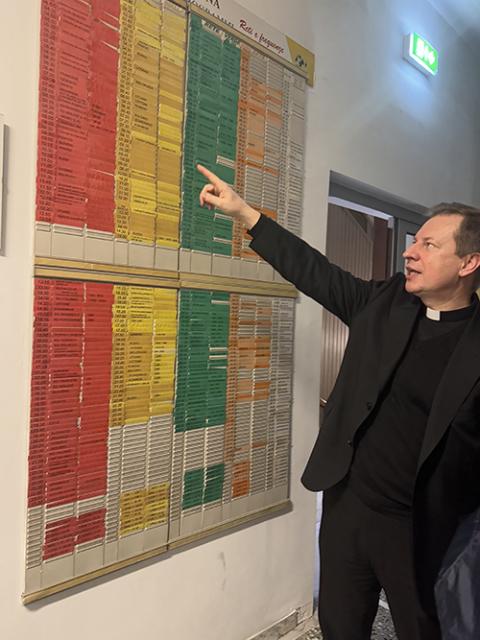
Fr. Paweł Rytel-Andrianik points to the board showing the stations and transmission times in different languages for Vatican Radio Jan. 22, 2025. (Helga Leija)
During World War II, Vatican Radio became a lifeline for families searching for missing loved ones. At Pope Pius XII's request, the station collected names of prisoners of war, refugees and displaced persons and broadcast them in multiple languages. Families listening across Europe and beyond could hear if their loved ones' names were mentioned, offering people a chance to reconnect during the chaos of war. This humanitarian effort became a lifeline at a time when communication was nearly impossible, especially for those in prison camps or occupied territories. By using radio waves to bridge distances, Vatican Radio helped reunite thousands of families and reinforced the Catholic Church's mission of compassion and aid during the war.
Transformative discussions
On the second day, we attended powerful presentations at the Vatican Apostolic Library. Various panels and discussions explored themes, including the following:
- "Sisters Communicating Communion with the Marginalized"
- "The importance of connection and communications"
- "Participatory storytelling"
- "Shifting narratives and storytelling"
- "The future of communication in 'traditional' media formats"
- "Communicating Communion in the world of AI"
- "Transforming social media in spaces of communion."
The stories shared by the presenters were incredibly moving, particularly in their demonstration of how sharing real-life anecdotes with the media is vital to helping those they minister. Missionary of Jesus Sr. Norma Pimentel, director of Catholic Charities of the Rio Grande Valley, spoke about a six-year-old girl whose legs were severed by "The Beast," the freight train used by migrants trying to reach the U.S. Sacred Heart of Jesus Sr. Rosemary Nyirumbe, director of St. Monica's Centre in Uganda, shared heartbreaking stories of girls rescued from the Lord's Resistance Army. Maryknoll Sr. Abby Avelino of Talitha Kum recounted the trauma an eight-year-old girl faced when she was sexually exploited by her aunt.
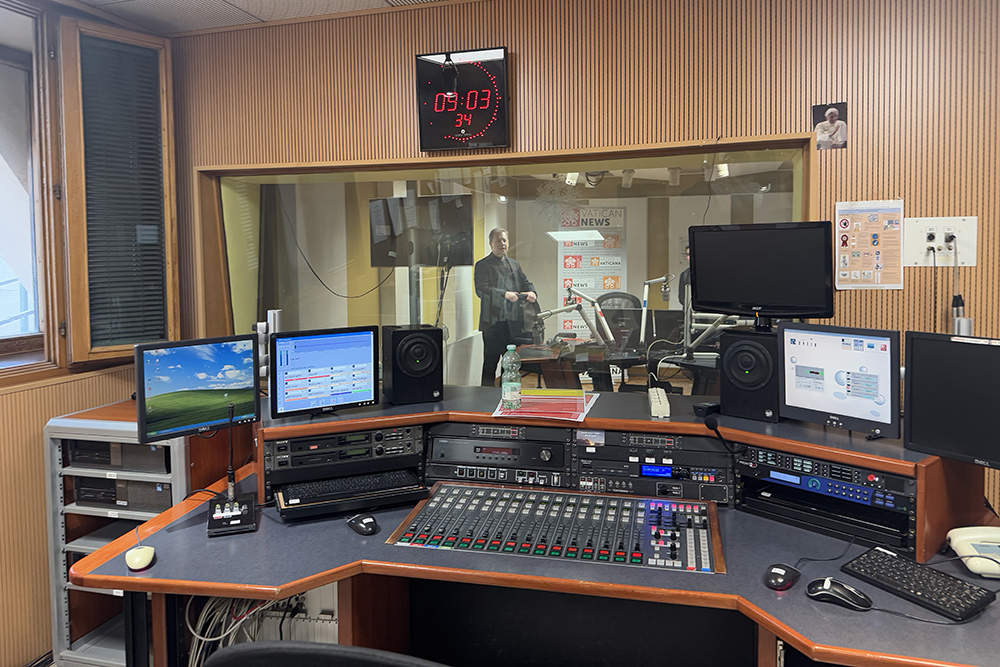
The recording studio at Vatican Radio. (Helga Leija)
Many presenters shared powerful testimonies of their work with victims of violence, trafficking and poverty in places like Uganda, the Philippines and the U.S.-Mexico border. By communicating these stories with media, sisters said, they're able to put a human face to an issue that otherwise might remain a statistic or distant problem to those who follow the news.
Sr. Lismy Parayil, a member of the Congregation of Mother of Carmel, highlighted the role of film in addressing cultural and social issues while offering messages of faith and hope. A common theme among all the presenters was the need to communicate hope through our ministries — something consistent with this year's Jubilee theme.
We engaged in Conversations in the Spirit, learning about each other's realities. One key takeaway from this conference was that the stories we tell do not belong to us; we simply help to amplify the voices of the people we serve.
A papal audience
On Saturday, Jan. 25, we had the opportunity to walk through the Holy Doors of St. Peter's Basilica and then attend a private audience with the Holy Father at the Paul VI Audience Hall. The audience included many communicators from around the world, including young people.
The audience started early, and Pope Francis' presence filled the auditorium. His warm, genuinely happy smile radiated throughout the room. During the audience, he urged us all in the communication field to promote a type of communication that can heal the wounds of humanity, one that nurtures by making room for a "heartfelt trust that, like a slender but resistant flower, does not succumb to the ravages of life, but blossoms and grows in the most unexpected places."
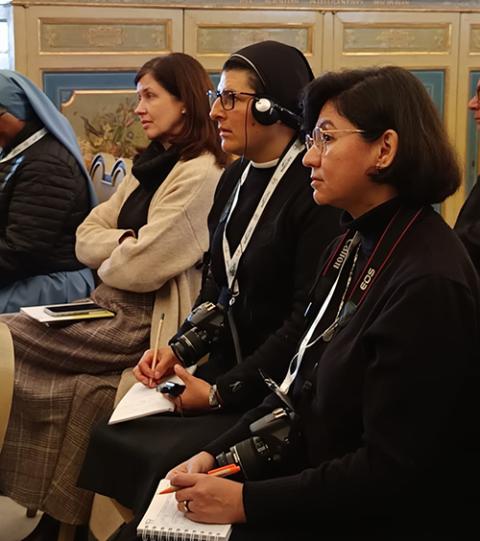
Attendees listen to the conference Jan. 23, 2025, at the Vatican Apostolic Library. (Helga Leija)
He spoke of this trust being present in the prayers of mothers who long for their children's safe return from war, and in the dreams of fathers who risk it all to build a better future in a different country. The people sisters serve.
In a time when people do not always trust the media — or even the clergy — nuns still have credibility and the trust of those they serve. This is a tremendous responsibility.
Our role as communicators within the church is not just about reporting facts; it is about being witnesses of hope, sharing the stories of those on the margins, and ensuring that their voices are heard.
The opportunity to attend the Jubilee was truly amazing. The spirit of Pentecost was alive throughout the conference. Just as in that first Pentecost, where people from different nations understood the message in their own languages, we, too, found unity in our diversity.
I learned a bit about photography from the fabulous Parayil, learned about school systems in Poland, and trafficking realities in Brazil, among many other things. And, of course, I enjoyed real Italian pizza and good wine.
Despite coming from different cultures, languages and backgrounds, we shared a common mission: to bring hope to the world through communication.
It was an experience I will treasure forever.

